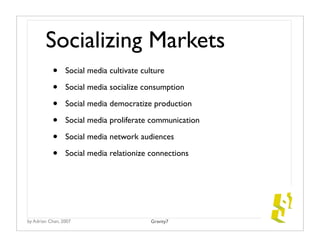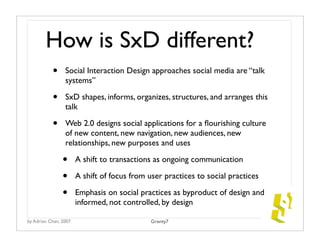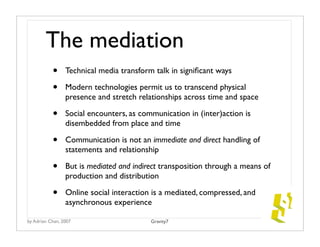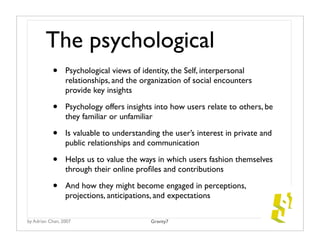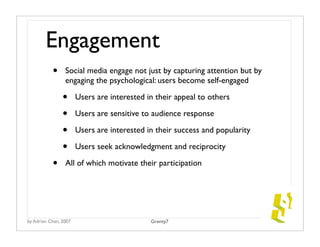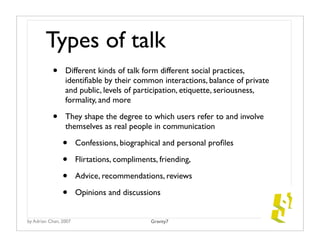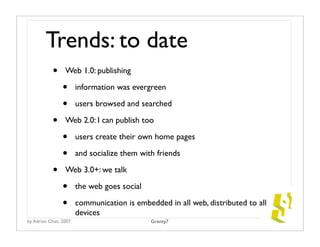What Is Social Interaction Design?
- 1. Social Interaction Design An Introduction to SxD Adrian Chan Gravity7.com
- 2. What is SxD? • Design of social media • Involves all web design disciplines: User Interface, Interaction design, Experience design, Information Architecture • Social media include networked applications that permit direct and indirect, private and public communication and interaction • Social media platforms may be computer-based or mobile, even game platforms • They engage the participation of users • User participation produces mediated social practices by Adrian Chan, 2007 Gravity7
- 3. Social media • Social media are reshaping the marketplace for information and knowledge, goods and services • They supplement marketplaces with the power of communication • Communication unfolds in the form of conversations of varying depth, reach, and speed • Relationships inform the availability and value of information • All of which is changing the way our culture produces and consumes value • And presents a challenge to mass media and the organization of conventional media-based marketplaces by Adrian Chan, 2007 Gravity7
- 4. Social media • Social media are not just websites, but are dynamic social systems • Their User Interface is a Social Interface • Their content is people • Their people are contributors • Their contributions communicate • That communication is a form of talk • That talk is informed by design by Adrian Chan, 2007 Gravity7
- 5. The trade: Social Media by Adrian Chan, 2007 Gravity7
- 6. Socializing Media • Social media = paradigm shift in marketing and advertising • consumers participate in production and messaging • messages are their own, and have authenticity • using their relationships and social networks for communication • on the basis of their own interests • How social media structure and organize talk changes branding, marketing, and advertising • At stake is how markets produce and consume value by Adrian Chan, 2007 Gravity7
- 7. Socializing Markets • Social media cultivate culture • Social media socialize consumption • Social media democratize production • Social media proliferate communication • Social media network audiences • Social media relationize connections by Adrian Chan, 2007 Gravity7
- 8. How is SxD different? • Social Interaction Design approaches social media are “talk systems” • SxD shapes, informs, organizes, structures, and arranges this talk • Web 2.0 designs social applications for a flourishing culture of new content, new navigation, new audiences, new relationships, new purposes and uses • A shift to transactions as ongoing communication • A shift of focus from user practices to social practices • Emphasis on social practices as byproduct of design and informed, not controlled, by design by Adrian Chan, 2007 Gravity7
- 9. SxD in theory by Adrian Chan, 2007 Gravity7
- 10. Main concepts • Users of social media have: • the ability to become self-involved online, and to relate through social media to others (mediated presence) • expectations of future interaction (commitment) • a sense of self and a (self) perception of how they look to others (validation) • an intention to sharing their professional and/or personal interests (social motivation) • relationships they maintain online (social networks) • trust and confidence in the system (competence) by Adrian Chan, 2007 Gravity7
- 11. Interactions = Social • Conventional user interaction and user interface approaches address the user’s interaction with the device • The designer designs the screen • The interaction is User—Software • The Social Interaction Designer also designs beyond screen • The interaction of User—Software —User by Adrian Chan, 2007 Gravity7
- 12. User Needs = Interests • Shift from task and goal-oriented transactions common to traditional software use. • Non-social software: users have needs • Social media: users have interests • Social media are relational media: users are interested social participants • Users not satisfied by success in discrete transactions and actions, as in non-social software • Users sustain interest in own participation • Social media: emphasis on sustaining participation, communication, and interest by Adrian Chan, 2007 Gravity7
- 13. User Needs = Interests • The user’s psychological interests include acknowledgment, recognition, membership, attention, respect, attraction, citation, compliments, pleasure, self- satisfaction, popularity, etc, and the avoidance of risk, failure, embarrassment, disappointment, etc. • The user’s communicative interests include visibility, attention, organization of place and form of communication, etc. by Adrian Chan, 2007 Gravity7
- 14. The mediation • Technical media transform talk in significant ways • Modern technologies permit us to transcend physical presence and stretch relationships across time and space • Social encounters, as communication in (inter)action is disembedded from place and time • Communication is not an immediate and direct handling of statements and relationship • But is mediated and indirect transposition through a means of production and distribution • Online social interaction is a mediated, compressed, and asynchronous experience by Adrian Chan, 2007 Gravity7
- 15. The communicative • The medium screens out affective and communicative face to face cues • Its mediation of communication decouples the utterance from the act of uttering • Communication is captured and re-presented using text, images, video, audio • Interaction is decoupled from its performance • Interaction is captured and re-mediated asynchronously by Adrian Chan, 2007 Gravity7
- 16. The sociological • Our understanding of user behavior and social practices benefits from the insights of psychology, communication, and social theories • Online social interactions are a new kind of talk • The social is a figment and an effect of individual user contributions • It is observed, tracked, and re-presented through usage and data • The togetherness of social media is simultaneous and co- present but always interrupted, stretched, disassociated • Social forces and power are transformed by mediation by Adrian Chan, 2007 Gravity7
- 17. The psychological • Psychological views of identity, the Self, interpersonal relationships, and the organization of social encounters provide key insights • Psychology offers insights into how users relate to others, be they familiar or unfamiliar • Is valuable to understanding the user’s interest in private and public relationships and communication • Helps us to value the ways in which users fashion themselves through their online profiles and contributions • And how they might become engaged in perceptions, projections, anticipations, and expectations by Adrian Chan, 2007 Gravity7
- 18. The temporal • Social media organize time • Our experience of social time is episodic, eventful, and has duration • In communication, it may be deferred, interrupted, stretched, or cut off • We relate to this kind of time with anticipation and expectation • Social activity is temporal, has pacing and rhythm, speed and intensity • Any social technology structures time and is fast, slow, near, far, and so on by Adrian Chan, 2007 Gravity7
- 19. The paradigm by Adrian Chan, 2007 Gravity7
- 20. Shift of paradigm • From individual users to social practices • User provides content, and content is people • Grounded in the personal, biographical, and the everyday • Personally and socially meaningful activities and mediated forms of talk and interaction • New modes of organizing attention • New forms of value and differentiation • New channels for messaging • New means of capturing audiences by Adrian Chan, 2007 Gravity7
- 21. The Social Paradigm • User as a social Self • User as self-interested and interested in others • All activity is social (visible to some others) • Interaction is Participation • Participation is a form of talk • Talk has new forms and languages • New forms include posts, comments, reviews, ratings, gestures and tokens, votes, links, badges, video • New forms are distributable and communicable by Adrian Chan, 2007 Gravity7
- 22. Social is represented • Social media must create and represent social interaction and community • There are no direct faces or interactions -- only text, images, video, audio, and structured activities captured in media of re-presentation • Users behave according to what they believe is going on and what they believe matters to the audience • Users establish a relation to the audience and community based on its users, themes, and identity by Adrian Chan, 2007 Gravity7
- 23. Social Interaction • In any social encounter a participant seeks to know: • What’s going on? • If the interaction is familiar, s/he will have a sense of: • How to proceed • What to do next • Users of social media obtain this from the participation of others on the site by Adrian Chan, 2007 Gravity7
- 24. It’s all talk • Talk is addressed to an audience, of one, two, a group, or a public • Codes and forms of talk organize social media • Talk is direct (to addressee) or indirect (in front of audience) • Communication technology publishes and archives pages, posts, comments, and media • Interaction technology captures and transmits direct interactions: IM, direct messaging, by Adrian Chan, 2007 Gravity7
- 25. Themes • The identity of a social media service is thematic • Themes communicate What’s Going On which tells users How to proceed • Career networking and passive job search • Dating and flirting • Verticals: music, movies, books, pets • Shopping, reviewing, “best of” and “new” • Classifieds, listings, marketplaces • News, feeds, press, blog coverage by Adrian Chan, 2007 Gravity7
- 26. Activities are Social • Social media are designed around social activities • Activities structure the talk and the action • Activities use participants, context, themes • These organize who talks, about what, what happens, when and how frequently, for how long • All of which must be represented meaningfully • And which must be self-sustaining and alive by Adrian Chan, 2007 Gravity7
- 27. Actions are social • Social action common to social media is linguistic, communicative, representative, attention-getting, inviting, participatory, and responsive • These are social acts and action (organized in activities) • Ask, question, query, solicit, hint, wink, imply... • Recommend, suggest, offer, declare, promote, advertise... • Review, opinionate, show off, rant, challenge.... • Rate, rank, affirm, confirm, accept, approve.... • Favorite, tag, bookmark, link, share.... by Adrian Chan, 2007 Gravity7
- 28. Assembling audiences • Social media capture audiences • Their challenge is to produce active and participating audiences • Around themed, topical, product or market-oriented content • That is largely produced and consumed by the system’s members by Adrian Chan, 2007 Gravity7
- 29. Organization • The system organizes interaction through its • Presentation of users (personal, professional, etc.) • Their contributions (conversation, opinions, announcements, etc.) • Layout and navigation (focus on people, posts, media, etc.) • Use of representations and visual languages (tokens, icons, gifts, products, lists, etc.) • Management of time (fast, slow, ephemeral, archived, etc.) • Representation of collective use and community by Adrian Chan, 2007 Gravity7
- 30. Forms • Social media borrow from common cultural forms • Fashion, news, politics, entertainment, etc. • These forms arrange and organize information, events, and participation • Which organize how we talk about and show: success, celebrity, popularity, news, trends, relevance, etc. • Each social media system is unique in its forms of talk and formats of representation by Adrian Chan, 2007 Gravity7
- 31. People are Content • Social media make users visible through their contributions • They structure those contributions so that the system reproduces itself out of its own participating members • Communication is content • Contributions communicate • Contributions create navigation • Social navigation communicates by Adrian Chan, 2007 Gravity7
- 32. Engagement • Social media engage not just by capturing attention but by engaging the psychological: users become self-engaged • Users are interested in their appeal to others • Users are sensitive to audience response • Users are interested in their success and popularity • Users seek acknowledgment and reciprocity • All of which motivate their participation by Adrian Chan, 2007 Gravity7
- 33. Presentation of Self • The user’s participation in online media is informed by his or her sense of self and self image • Individual users actively create, maintain, tweak, and monitor their online Self • They have a self interest in seeing their online presence acknowledged and reflected • They use social media as an extension of themselves, often telling about and narrating biographical details and reflecting how they would like to be seen • May be sensitive to self image, self perception, acknowledgment, status, position, success, and so on by Adrian Chan, 2007 Gravity7
- 34. Social Presence • Social presence is about seeing and being seen • Any social presence sets up the need to negotiate and handle presence availability (to others) • Presence can be maintained with a persistent online profile • Messaging and updating lend presence greater immediacy • Presence tools vary in their organization of self talk, updates, distribution • Presence tools vary in their handling of interaction, communication, and availability by Adrian Chan, 2007 Gravity7
- 35. Paradoxes • Social = anti-social • Communication = non-communicative • Self = Self Image • Other = Imagined Other • Presence = Absence • Identity = Changing • Personal tastes are highly social • Utility can be useless by Adrian Chan, 2007 Gravity7
- 36. Practicing SxD by Adrian Chan, 2007 Gravity7
- 37. SxD: The palette • Design of the UI for social interface • Design of the application for social interaction • Design of communication for user generted content • Design of navigation for social and cultural tastes • Design of content modules for social navigation • Design of interaction elements for social practices • Design of media types for new forms of communication • Design of interaction tools for new kinds of social practices by Adrian Chan, 2007 Gravity7
- 38. Functional dysfunction • What functions is sometimes dysfunctional from a conventional software perspective • Communication and interaction are more than efficiency, effectiveness, and success • What is ambiguous compels • What is withheld piques curiosity • What is deferred sustains interest • What is substituted feeds the imagination • What is unclear solicits communication and help by Adrian Chan, 2007 Gravity7
- 39. Design levers • Design of the screen (first order) shapes overall user activity and community (second order) • Social interaction design anticipates second order effects and outcomes of UI, IA, interaction design choices • Social interaction design is indirect, informing, structuring, ordering, and arranging • Individual user actions and activities add up to social practices • It’s the interactions among users that design informs • Social interaction design is the application of levers to steer and guide emerging social practices by Adrian Chan, 2007 Gravity7
- 40. Users Own It • The social media application platform is not in our hands — it must be handed over to users and the community of users • Shift of thinking from “what it does” to “what users do with it” • Users need to feel that it is theirs, need to own it and their relationship to it • Create the system so that it can become what it will mean to each user, and as a result, service the community by Adrian Chan, 2007 Gravity7
- 41. Attention economies • The attention economy addresses online activity • It wants to capture user interest and attention • But it is difficult to measure attention as a quantity • does the user communicate it? to whom? how often? • does the user respect and like it? really? how much? • does the user return for more of it? frequently? for the same amount? • Attention spent on a brand, a thing, event, or even an idea belongs to one kind of attention economy by Adrian Chan, 2007 Gravity7
- 42. Attention economies • On social media, the economy of attention is measured by interest • Attention in social terms is quantity but also quality • Interest in social terms is not a thing, it’s a relation • Relations have intensities, direction, flux • The attention that matters in social media can include: • communicability; taste and preference; leadership and deference; trust and respect; authority and credibility; etc. by Adrian Chan, 2007 Gravity7
- 43. Call to action • Call to action is not always the conventional call to action • call to action is social • is often contributed (written, posted) by users • can be a call to interaction • can be a call to participation • can be a call to communication • can be a call on the attention of other users • Galvanize users to continue to create content that serves to mobilize others to do the same by Adrian Chan, 2007 Gravity7
- 44. Appealing to the Other • Social media content must help users appeal to each other • Personal style, online profile, character and personality • Appearance, looks, pictures, poses, qualities • Knowledge, know-how, expertise, credibility • Informal social position by friends, network, popularity, testimonials, compliments • Formal social position by profession, rank, status, accreditation, employer • Social capital by value to users and community by Adrian Chan, 2007 Gravity7
- 45. Common practices • Social practices emerge on social media as use becomes another way of maintaining and participating in relationships • Tell by posting • Show by uploading • Talk by commenting • Seek by querying • Ask by questioning • Opinionate by blogging • Associate by tagging by Adrian Chan, 2007 Gravity7
- 46. Types of talk • Different kinds of talk form different social practices, identifiable by their common interactions, balance of private and public, levels of participation, etiquette, seriousness, formality, and more • They shape the degree to which users refer to and involve themselves as real people in communication • Confessions, biographical and personal profiles • Flirtations, compliments, friending, • Advice, recommendations, reviews • Opinions and discussions by Adrian Chan, 2007 Gravity7
- 47. Windows and Views • Views of information, stats, traffic, and activity measure, describe, and show user and audience participation. • Views create aggregate perspective • Users look at views • Windows containing user generated content are a selection of relevant contents • Windows contain • Users look through windows • Users take interest in others • clickthroughs, rating, favoriting, friending, tagging, etc by Adrian Chan, 2007 Gravity7
- 48. Reflections and Mirrors • Social media show users their own activity back to them • Reflections show users their presence to others • Users are interested in how they appear and how they appear to others • Mirrors show users their reflection • Users need to see themselves represented • Users take interest in themselves • numbers, ranking, ratings, votes, friends, testimonials, lists, gestures, winks, compliments all reflect upon the user by Adrian Chan, 2007 Gravity7
- 49. System Feedback • It’s necessary to show users their own actions, particularly the social consequences and reception of their actions • Users need to establish trust in the system’s own functions and features • Users want to feel competent users of the system • The system’s feedback is confirmation of their actions and recognition of their competence • Much system feedback is provided by other users, displayed and organized by design by Adrian Chan, 2007 Gravity7
- 50. Transference • In the absence of immediate response and reaction to user participation, users invent and project their interpretations and assumptions • Self involvement and involvement in others is mediated and engages projection and introspection • Projective: seeing • Commenting, rating, digging, favoriting, tagging • Introspective: being seen • Blogging, recording video performances, journaling, profile maintenance and tweaking by Adrian Chan, 2007 Gravity7
- 51. Projection • Users will project the other’s intentions, motives, interests, desires, skills, and other attributes based in part on what they hope for or wish to see • Users particularly project into ambiguity and communication and when user identities are concealed or only partially revealed • Projection can result in users over-communicating and over- compensating • Projection may be more Other-oriented by Adrian Chan, 2007 Gravity7
- 52. Introspection • Some social media user practices primarily engage the user with him or herself • In these kinds of activities, users become involved in their own ideas, perceptions, interpretations, and assumptions • Introspection can result in users engaging primarily in telling about themselves and crafting an online persona • Introspective activities may appear as a distant and anti-social performance • Introspection may be more Self-oriented by Adrian Chan, 2007 Gravity7
- 53. Social networking • Social networks are the maintenance and sustaining of personal and professional relationships on social media • Social networks limit content access to known, familiar, and trusted associations • Relationships embody trust in the first degree • Relationships extend confidence in the second degree • Social networks expand content access while limiting results by Adrian Chan, 2007 Gravity7
- 54. Distribution • Some social media are built as destination sites and “walled city” domains • Some social media extend their presence through widgets, badges, and shared data beyond their domain • to the desktop • to mobile • to other networked devices by Adrian Chan, 2007 Gravity7
- 55. Folksonomies • Flat and non-hierarchical navigation through content categories, labels, and tags that reflect their popularity in use • Self-reinforcing associations as use by communities of users privilege tags used most • Provide a view of the values and selections most popular among users • Permit change and news to continually reach the surface • Are a snapshot in time and are thus current by Adrian Chan, 2007 Gravity7
- 56. Mini Me-dia • Mass media inform the content and organization of social media • Cultural and social references and presentations are readily available in the mass media and by virtue of digital distribution are easily quoted and repurposed • Social media are user-centric • Personal is news • Person is privileged • Personality is popular by Adrian Chan, 2007 Gravity7
- 57. Trends: to date • Web 1.0: publishing • information was evergreen • users browsed and searched • Web 2.0: I can publish too • users create their own home pages • and socialize them with friends • Web 3.0+: we talk • the web goes social • communication is embedded in all web, distributed to all devices by Adrian Chan, 2007 Gravity7
- 58. Trends: the future • Faster and lighter applications and tools • Higher presence and immediacy of the user • Niche social networks • Fewer new attempts at all-in-one destinations • Branded social media and social media brands • Recognition by mass media, increasing assimilation and integration • Distributed and widgetized • Non-browser based apps widgets and mobile by Adrian Chan, 2007 Gravity7







